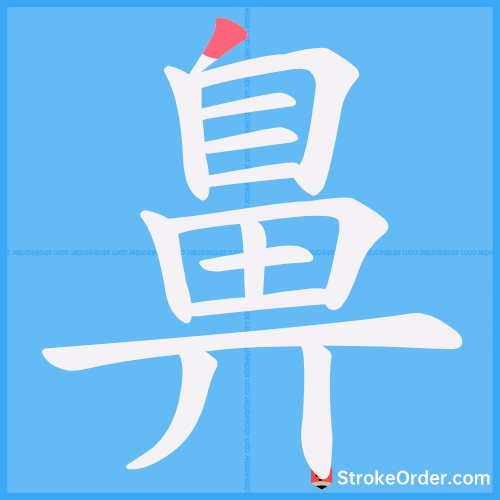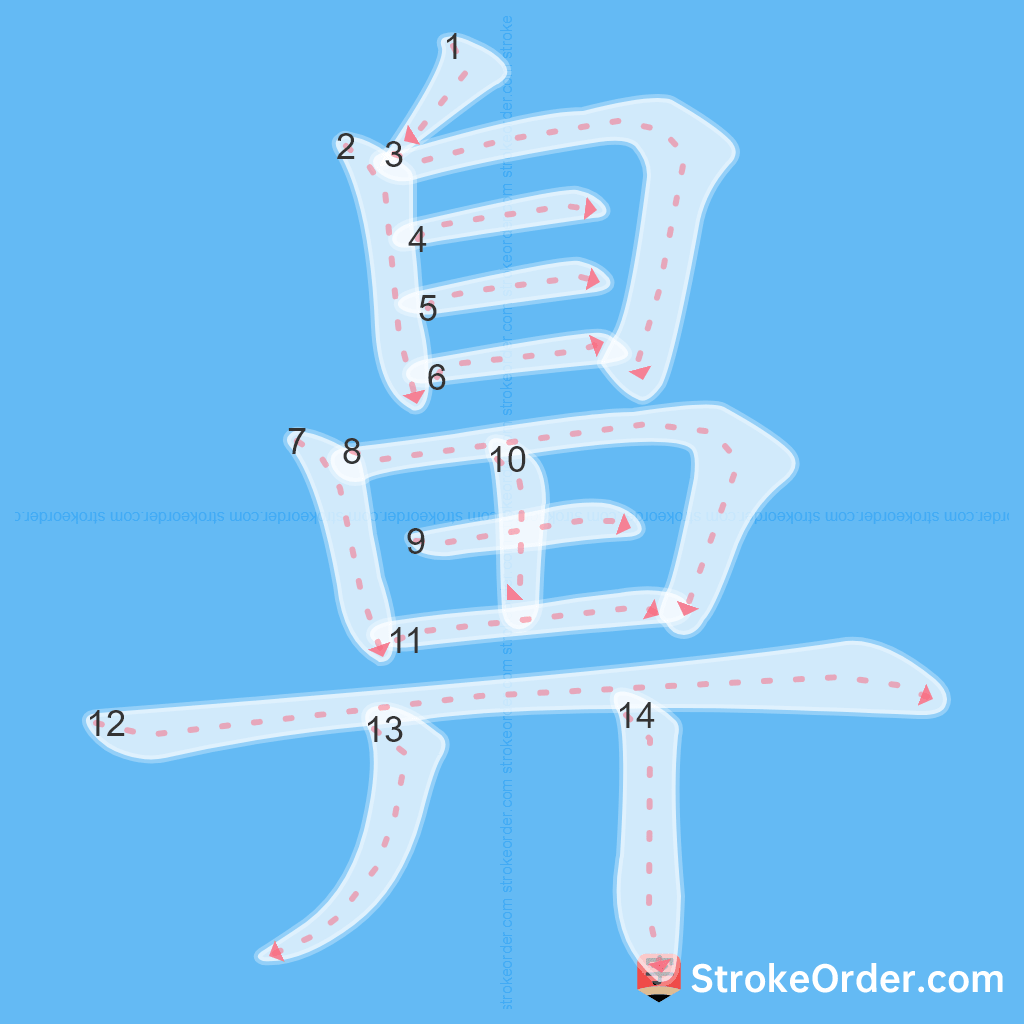鼻 Stroke Order
Animated Stroke Order of 鼻

Stroke Order Diagrams for 鼻

Step-by-Step Handwriting Guide for 鼻

Learn to Write Chinese Characters with Video Tutorials
Watch the video of writing the Chinese character "鼻", learn the correct stroke order (笔顺) of the character "鼻", and master the standard way of writing the character "鼻".
Free Printable Handwriting Practice with Stroke Order: 鼻
Printable Writing Practice Worksheet of "鼻" in Portrait Orientation (Tian Zi Ge)

Printable Writing Practice Worksheet of "鼻" in Landscape Orientation (Tian Zi Ge)

Information of 鼻
Pinyin
bí
Radical
鼻
Strokes
14 strokes
Usage
★★★★★
Definition
nose
鼻 [bí]
(名)
【本义】: 鼻子
1. 嗅觉器官,亦是呼吸器官之一。
(En: The organ of smell and one of the organs of respiration.)
例如:鼻子、鼻窦、鼻孔、鼻腔、鼻涕、鼻音、鼻烟(由鼻孔吸入的粉末状的烟),仰人鼻息,嗤之以鼻。
2. 创始;开端。
(En: Origin; beginning.)
例如:鼻祖。
【引】
1. 《说文》:鼻,引气自畀也。
(En: "Shuowen": Nose, the air is brought from oneself.)
2. 《老子》:天食人以五气从鼻入,地食人以五味从口入。
(En: "Laozi": Heaven nourishes man with the five airs entering through the nose, earth nourishes man with the five flavors entering through the mouth.)
3. 《白虎通》:鼻出入气高而有窍,又,鼻者,肺之使。
(En: "Baihu Tong": The nose has high air passages and openings, and it is the servant of the lungs.)
4. 《易·噬》:肤灭鼻。 虞注:“艮为鼻。”
(En: "Yijing": The flesh extinguishes the nose. Yu's note: "Gen represents the nose.")
5. 《荀子·荣辱》:鼻辨芬芳腥臊。
(En: "Xunzi": The nose distinguishes between fragrance, fishy, and foul smells.)
【例】
例如:鼻哂(即嗤之以鼻,轻视、嘲笑的表情)、鼻饮(用鼻饮水)、鼻准(鼻子的尖端)。也指某些器物上的隆起或孔状部分,如:印鼻、针鼻儿、门鼻儿、鞍鼻。
2. 初始,发端。
(En: Origin; beginning.)
例如:鼻,始也。兽之初生谓之鼻,梁益之间谓鼻为初,或谓之祖。
(En: "Dialect Thirteen": Nose means beginning. The initial form of animals is called nose; in Liangyi, it is called the beginning, or referred to as the ancestor.)
《汉书·扬雄传》:有周氏之婵嫣兮,或鼻祖于汾隅。
(En: "Han Shu, Yang Xiong Zhuan": There is a beautiful woman from the Zhou family, perhaps regarded as the ancestor in Fen's corner.)
Input Method for 鼻
Pinyin
bi2
Wubi
thlj
Cangjie
huwml
Zhengma
nlan
Four Corner
26221
Unicode
U+9f3b
Same Pronunciation Characters